Evaluating Established Technologies: Successes and Shortcomings

In the rapidly evolving world of technology, evaluating established systems is crucial to understanding both their successes and shortcomings. These evaluations help guide future developments and offer insights into how we can improve or adapt current technologies. Established technologies such as the internet, smartphones, and GPS have transformed how we communicate, work, and navigate our daily lives. While they have brought immense benefits, they also present challenges that need to be addressed to ensure their continued relevance and efficiency.

One of the primary successes of technologies like the internet is the global connectivity it has provided. The internet has bridged vast distances, enabling instantaneous communication and access to information, transforming industries from education to healthcare. It has allowed for remote work and learning, particularly valuable in times of crisis such as the COVID-19 pandemic. Similarly, smartphones have revolutionized personal communication, entertainment, and business, offering an all-in-one device that serves as a phone, camera, calendar, and much more.

However, these technologies also have their shortcomings. The internet, while connecting the world, has also brought issues like misinformation, privacy concerns, and online security threats. Social media platforms, in particular, have faced criticism for their role in spreading false information and contributing to mental health issues. Similarly, while smartphones have become indispensable tools, they have also raised concerns about addiction, privacy violations, and their impact on face-to-face social interactions. GPS, another widely used technology, is reliable but can be prone to inaccuracies in certain environments, such as dense urban areas or remote locations.

To address these gaps, continuous evaluation and innovation are necessary. Technology companies and developers must assess user feedback, anticipate new challenges, and make improvements that enhance the user experience while addressing existing issues. By critically evaluating the benefits and limitations of established technologies, we can better understand how to optimize their use and guide the development of future innovations.


